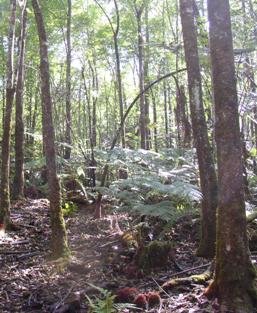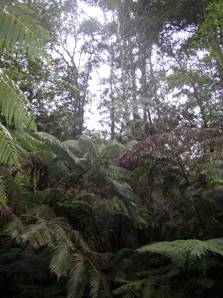Exotic plants can be water-hoggers
We often think of vegetated areas as being ecologically friendly; that is, plants are good for the environment, right? But it turns out that even that statement has caveats. In a study out in this month’s Ecological Applications, researchers have found that some exotic trees in Hawaii can use water at a rate of more than twice that of native trees. This greedy water consumption could spell trouble for the island state, where fresh water is already in short supply.
 Lawren Sack of UCLA and his colleagues compared the water use of trees in native forests (below), composed mostly of native ohia trees, with water use in timber plantations (left) containing exotic eucalyptus and tropical ash. The team monitored the rate of sap flow through the tree: a faster flow rate means that the tree is using more water.
Lawren Sack of UCLA and his colleagues compared the water use of trees in native forests (below), composed mostly of native ohia trees, with water use in timber plantations (left) containing exotic eucalyptus and tropical ash. The team monitored the rate of sap flow through the tree: a faster flow rate means that the tree is using more water.
 The team found that individual eucalyptus and tropical ash used three and nine times more water, respectively, than individual ohia trees. Since each of these forests is dominated by these three species, the team scaled up their results to predict how much water a whole section of forest uses. Even when including other native plants that use water quickly, such as tree ferns, the tropical ash forests still used water at a rate of 1,800 grams of water per square meter per day, more than 2.5 times that of the other forests.
The team found that individual eucalyptus and tropical ash used three and nine times more water, respectively, than individual ohia trees. Since each of these forests is dominated by these three species, the team scaled up their results to predict how much water a whole section of forest uses. Even when including other native plants that use water quickly, such as tree ferns, the tropical ash forests still used water at a rate of 1,800 grams of water per square meter per day, more than 2.5 times that of the other forests.
In the early 20th century, Hawaii’s non-native tree plantations were originally intended for timber production and to conserve the islands’ top soil. At the time, however, the importance of biodiversity and the dangers of exotic species weren’t as clear as they are today. Especially with climate change rapidly changing many ecosystems, Sack says, it’s vital that land management plans recognize and integrate the fact that water use by plants can affect the clean water supply. Says Sack:
When making decisions to restore a native forest or preserve or establish a plantation, we need to do a more detailed valuation that includes the cost of water they’re using. There are a lot of reforestation projects underway to take up carbon dioxide from the atmosphere, where people are prioritizing fast-growing trees. But we shouldn’t let alien plants sweep over native forests. Our findings make a clear case that we need to know how much water landscapes are using and conserving.
Photos: Aurora Kagawa
Kagawa, A., Sack, L., Duarte, K., & James, S. (2009). Hawaiian native forest conserves water relative to timber plantation: Species and stand traits influence water use Ecological Applications, 19 (6), 1429-1443 DOI: 10.1890/08-1704.1